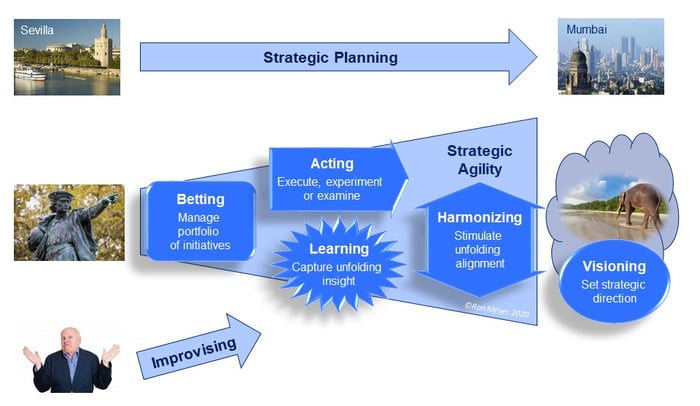How can I develop strategy in a volatile, uncertain, complex and ambiguous world?

Developing strategy is about setting a course of action to achieve a particular purpose. It is about determining a route forward, while fully aware that the future can’t be predicted because the world is inherently VUCA (volatile, uncertain, complex and ambiguous).
Strategic agility is an approach to developing strategy whereby an organization balances between committing itself to a course of action and retaining its ability to flexibly adapt to unfolding circumstances. As such, strategic agility balances between the fixity of strategic planning and the flexibility of improvisation.
Conceptual model
The Strategic Agility Model is based on the premise that you know that you don’t know the future and therefore that your strategy is your current best guess. If we did know the future, then we could draw up a detailed strategic plan of what to do (often called future-back planning). It would be like planning a trip from Sevilla to Mumbai, for which we could figure out the best possible travel itinerary. But the VUCA reality is that we are more like Columbus searching for a route from Spain to India, for which we have a current best guess but know that much will need to be found out along the way. As Columbus, we shouldn’t fall back on improvising, but take a structured approach to finding the best route forward.
The Strategic Agility Model suggests that there are five key strategizing activities that all need to take place simultaneously. The model doesn’t detail how the process should be organized but presents a general framework with which to approach strategy development.
Key elements
To be strategically agile requires carrying out the following key strategizing activities:
- Visioning. While it is impossible to know exactly where to go, one does need a rough estimate of the direction in which to head in order to set a course of action. Columbus didn’t have precise coordinates, but he did envision that India could be found to the West. Likewise, organizations need to constantly envision their desired destination, so they can focus people on taking actions that will move the organization in the preferred direction.
- Betting. While it is also impossible to know exactly what to do, one does need to take actions to move forward. That means taking calculated risks by betting on different initiatives, each with their own guesstimated risk/reward profile. Some initiatives will be sure bets, probably useful in any future, while others will be risky side bets, just in case the unexpected happens. Taken together, the portfolio of bets is the organization’s strategy.
- Acting. Depending on the risk of each bet, one can move into action in different ways. Where the risk is low because the predictability is deemed high, a relatively detailed plan can be made and executed. Where the risk is medium, it is often wise to commit less and experiment, using simulations or pilot projects. Where the risk is high, it is generally better to commit even less and examine, testing the ideas and feeling out support.
- Learning. Whichever form of acting is used, one knows that each bet is a guess and that new insights will probably emerge by doing. These unfolding learnings need to be captured and used to adapt the acting, so that a virtuous cycle of acting and learning evolves. The shorter these cycles and the quicker these cycles follow each other, the more flexible and adaptive it will be.
- Harmonizing. The portfolio of bets will be constantly changing, due to the cycle of acting and learning, with some initiatives being scaled up as they become less risky, while others will adapt course or even be discontinued. The challenge is to ensure that the various bets don’t pull the organization in different directions but are realigned into a consistent whole. So, say yes to the mess, but still attempt to harmonize initiatives along the way.
Key Insights
- Fair and fear as the two approaches to leadership. Leadership is the ability to influence others to move in a certain direction, and there are two types of influence; being fair builds trust and sways people to follow voluntarily, while fear triggers people to follow compliantly.
- Fairness is the high road to leadership. Acting fairly is a key ingredient of building trust between the leader and the followers. It generally takes long and requires considerable effort, but it is the route to winning hearts and minds and achieving lasting engagement.
- Three types of fairness. Leaders can be fair in the way they relate to others (fair attitude), in the way they deal with others (fair process) and in the way they share results with others (fair outcomes). The three forms are complementary and can reinforce each other.
- Fairness is in the eye of the beholder. While leaders might think they are behaving fairly, the only thing that matters to have influence is how the follower experiences a leader’s behavior. Therefore, leaders need to ensure that they are seen to be fair.
- Fear also works. But there is also a low road to leadership, which plays on fear to get people to comply. This approach works and is used by many, both intentionally and inadvertently. It is up to each leader to consciously choose which road they wish to take.
This blog is part of a series, if you want to see all the blogs, then click below:




